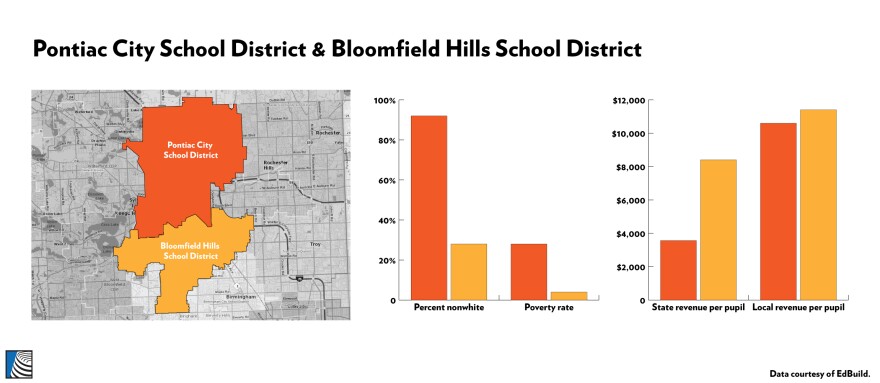A new report maps out which neighboring Michigan school districts are the most segregated by race, poverty, and revenue. It comes 45 years after the U.S. Supreme Court told white families in Michigan (and by extension, the nation) if they wanted to avoid mandatory school integration, all they had to do was move to a whiter district.
“As if quarantining students of color, we have forced them into racially dense and underfunded systems, and then built walls around them,” reads the report from EdBuild, an activist group aimed at disrupting “the status quo of illogical and inequitable school funding.”
School district lines are drawn on top of neighborhoods shaped by redlining and racist housing policies, the group argues.

One of the Michigan examples: Oak Park City School District and its next-door neighbor, Berkley School District. Their high schools are just two miles apart, and both are about the same size, with roughly 1,200-1,400 students.
But they’re among the most starkly segregated districts in the U.S., according to EdBuild. Oak Park is 97% nonwhite. Berkley is just 25% nonwhite. There’s a 14% gap in their poverty rates, and Oak Park gets $4,182 less in per pupil funding (when you combine both local and state revenue.)

Those disparities play out in student performance, too. In Berkley, 67% of students are proficient in all subjects on state tests – well above the state average of 40%. But in Oak Park, only 11% of students are proficient on those same tests.
Rebecca Sibilia, EdBuild’s founder/CEO, hopes the report makes people ask: What if we redrew our school districts?
“Folks need to stop thinking about district lines as if they were drawn by God,” Sibilia says, “and start thinking about what they would do if they were to build a new set of school districts that could be more inclusive, and reflective of lots of different students.”
Michigan’s legacy: a landmark school segregation case
By 1974, so many white families had fled Detroit for the suburbs, black kids like Ronald Bradley were going to city schools that were almost entirely black. Bradley’s family sued the school district, arguing that even 20 years after the court outlawed “separate but equal,” their kids’ educations were still segregated by default. They wanted integration enforced, not just between white and black schools, but between white and black districts, too.
And at first, they won. The lower courts found “district lines are simply matters of political convenience, and may not be used to deny constitutional rights.” Detroit and 53 neighboring suburbs were ordered to start integrating, a massive plan that would require involve more than half a million students.

But then, the U.S. Supreme Court overruled that plan. In the landmark Milliken v. Bradley case, the court said the suburbs weren’t explicitly banning black students; therefore, the majority said, they weren’t violating the Detroit students’ constitutional rights. Plus, the court argued, this plan would create a messy, unwieldy mega-district, and strip the suburban districts of their “local control.”
“...[S]chool district lines may not be casually ignored or treated as a mere administrative convenience,” the ruling held, because “substantial local control of public education in this country is a deeply rooted tradition.”
The Court’s decision was clear: the federal government can’t make schools integrate across district lines. It was a blow to civil rights advocates. As one district judge put it: “'How do you desegregate a black city, or a black school system?’”
In his dissent, Supreme Court Justice Thurgood Marshall said the ruling left Detroit’s students without hope for a solution.
“...[T]he Court's answer is to provide no remedy at all for the violation proved in this case, thereby guaranteeing that Negro children in Detroit will receive the same separate and inherently unequal education in the future as they have been unconstitutionally afforded in the past.”
What states can do now
Just because the Supreme Court says the federal government can’t mandate integration between districts, doesn’t mean the state legislature can’t reshape those borders, Sibilia says. And if that sounds far fetched at a time when even Democratic presidential candidates can’t agree if federally-mandated busing was a good idea, at least we’re talking about it, she says.
“Of course, there is always a political-will issue,” she says. “Political will defines everything. But I do think that it’s good news that we’re starting to talk about this more, again. We were kind of heavily focused on it for a while, but it fell out of favor in terms of important reforms to make to our education system. And the pendulum has definitely swung back to where it needs to be.”

But just like the busing debate, families in the wealthier, whiter districts will play a pivotal role.
“You don’t have to send your students to another district,” Sibilia tells them. “The answer is that we need to make larger districts, so that we can pull disadvantaged students closer to us, and give them access to kind of privilege that we have. This is not a matter of crossing school district borders for an individual parent. This is a matter of comprehensively redrawing school district borders.… I would argue it is the folks who have the wealth and resources, who should be calling for more inclusion for the students who live right across the street.”
Caroline Llanes contributed to this story.





